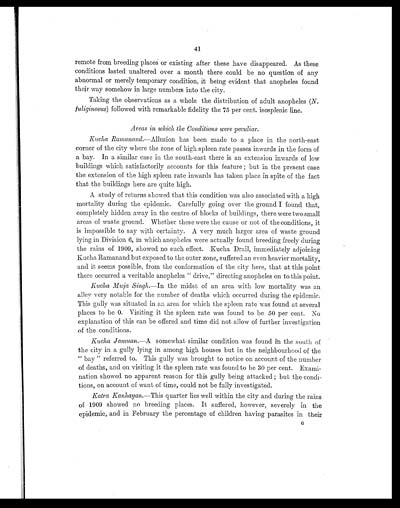Medicine - Institutions > Army health reports and medical documents > Scientific memoirs by officers of the Medical and Sanitary Departments of the Government of India > Number 46 - Malaria in the Punjab > Part II - Autumnal epidemic (fulminant) malaria
(53) Page 41
Download files
Individual page:
Thumbnail gallery: Grid view | List view

41
remote from breeding places or existing after these have disappeared. As these
conditions lasted unaltered over a month there could be no question of any
abnormal or merely temporary condition, it being evident that anopheles found
their way somehow in large numbers into the city.
Taking the observations as a whole the distribution of adult anopheles (N.
fuliginosus) followed with remarkable fidelity the 75 per cent. isosplenic line.
Areas in which the Conditions were peculiar.
Kucha Ramanand.—Allusion has been made to a place in the north-east
corner of the city where the zone of high spleen rate passes inwards in the form of
a bay. In a similar case in the south-east there is an extension inwards of low
buildings which satisfactorily accounts for this feature; but in the present case
the extension of the high spleen rate inwards has taken place in spite of the fact
that the buildings here are quite high.
A study of returns showed that this condition was also associated with a high
mortality during the epidemic. Carefully going over the ground I found that,
completely hidden away in the centre of blocks of buildings, there were two small
areas of waste ground. Whether these were the cause or not of the conditions, it
is impossible to say with certainty. A very much larger area of waste ground
lying in Division 6, in which anopheles were actually found breeding freely during
the rains of 1909, showed no such effect. Kucha Drail, immediately adjoining
Dacha Ramanand but exposed to the outer zone, suffered an even heavier mortality,
and it seems possible, from the conformation of the city here, that at this point
there occurred a veritable anopheles "drive," directing anopheles on to this point.
Kucha Muja Singh.—In the midst of an area with low mortality was an
alley very notable for the number of deaths which occurred during the epidemic.
This gully was situated in an area for which the spleen rate was found at several
places to be 0. Visiting it the spleen rate was found to be 50 per cent. No
explanation of this can be offered and time did not allow of further investigation
of the conditions.
Kucha Jamuan.—A somewhat similar condition was found in the south of
the city in a gully lying in among high houses but in the neighbourhood of the
"bay" referred to. This gully was brought to notice on account of the number
of deaths, and on visiting it the spleen rate was found to be 30 per cent. Exami-
nation showed no apparent reason for this gully being attacked; but the condi-
tions, on account of want of time, could not be fully investigated.
Katra Kanhayan.—This quarter lies well within the city and during the rains
of 1909 showed no breeding places. It suffered, however, severely in the
epidemic, and in February the percentage of children having parasites in their
G
Set display mode to: Large image | Zoom image | Transcription
Images and transcriptions on this page, including medium image downloads, may be used under the Creative Commons Attribution 4.0 International Licence unless otherwise stated. ![]()
| Permanent URL | https://digital.nls.uk/75058729 |
|---|
| Shelfmark | IP/QB.10 |
|---|---|
| Additional NLS resources: | |




